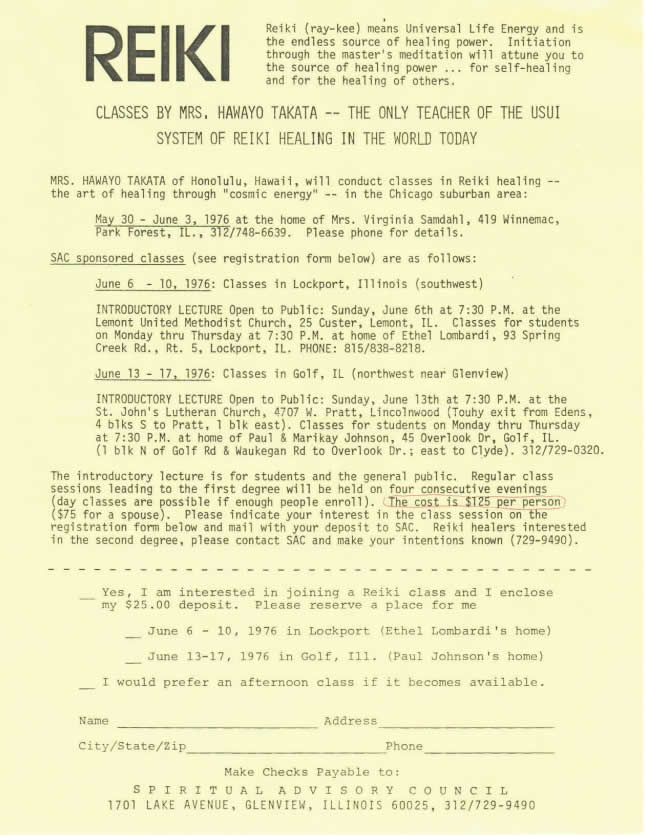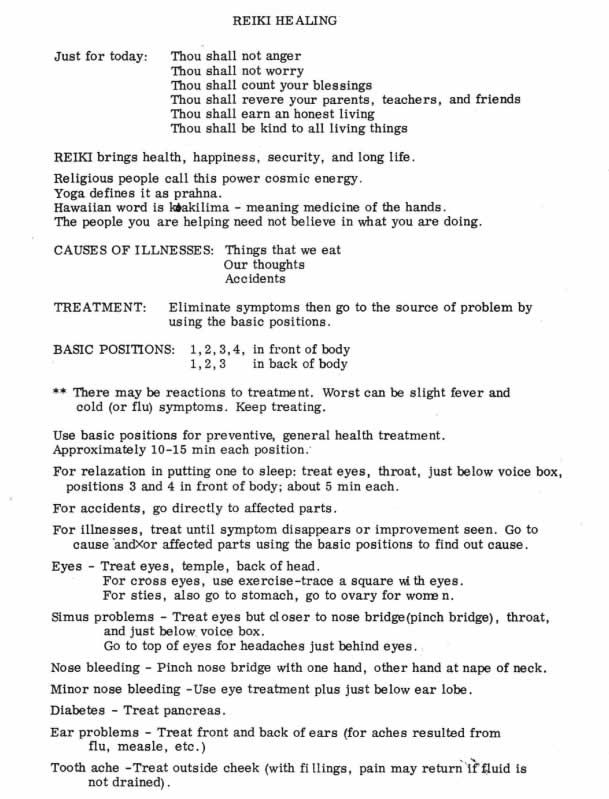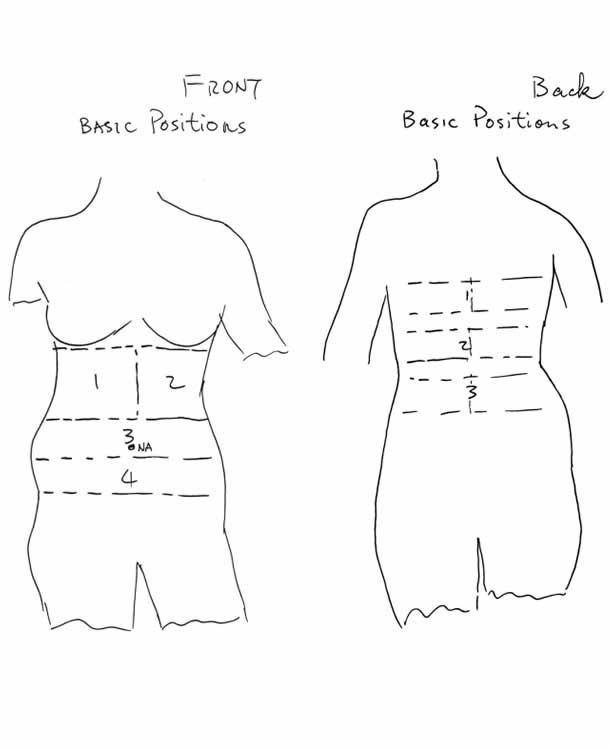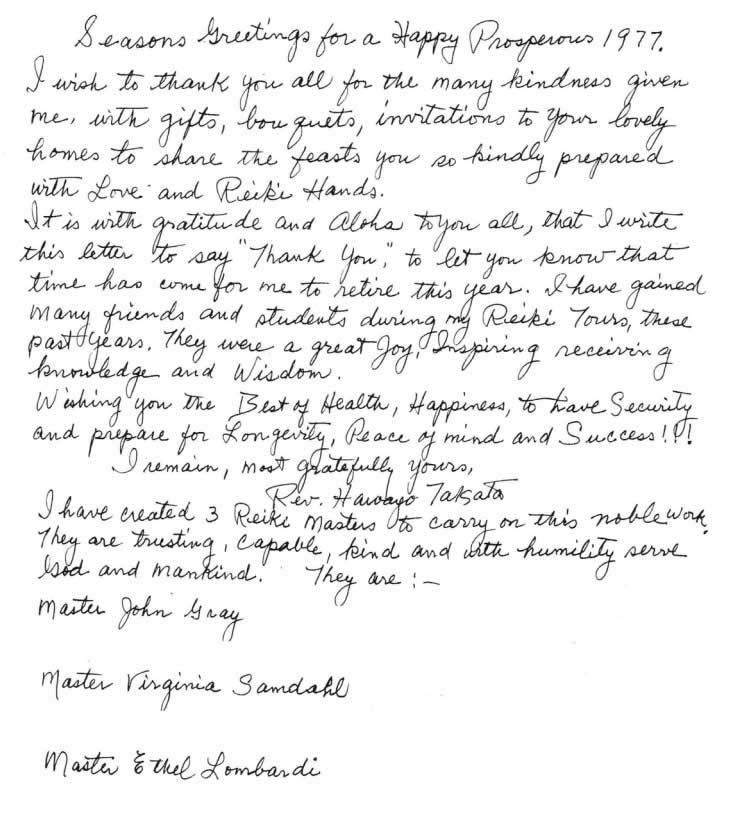高田女士的講義 Takata's Handouts

高田女士的講義 Takata's Handouts
威廉·李連 William Lee Rand
1938 年,高田夫人在林忠次郎老師在日本診所實習一年,在接受了他的培訓後,高田女士將靈氣帶到夏威夷。她成為一名有成就的治療師,練習和教授靈氣,直到 1980 年去世前,這段時間長達 40 多年。這是一項了不起的成就,因為她的工作使靈氣在二戰後不再默默無聞,並使靈氣成為一種流行的做法。從那時起,它已經發展到包括全球共有數百萬的靈氣從業者。
二戰後,日本國內的情況反而大大限制了有關靈氣訊息的傳播。高田女士的說法成為主要的來源。高田改變了林忠次郎老師教她的靈氣系統。據她的一名大師學生約翰·哈維·格雷 (John Harvey Gray) 說,高田告訴他,她簡化了系統,讓西方人更容易學習。這包括她教過的治療手位系統,並以七到八個手位代替它,她稱之為基礎治療。
她還遺漏了許多她從林忠次郎老師那裡學到的重要治療技巧。儘管她改變了林的系統,但她向大多數學生宣傳的主要說法,是她正在教授自臼井老師起創建未改變過的系統。在她的靈氣歷史版本中也存在這個錯誤事實。由於當時沒有關於靈氣的任何其他信息來源,學生們傾向於相信她。在她去世後,她的一些學生繼續推廣這個想法,從而使錯誤的信息永久化並阻礙了對創始人是如何實踐靈氣的相關研究。

高田女士當年的靈氣傳單
幸運的是,好奇心總會佔了上風,在 1990 年代,包括望月俊孝(Toshitaka Mochizuki)、Frank Arjava Petter 和 土居裕(Hiroshi Doi) 在內的幾位研究人員開始提供有關 林忠次郎 和 臼井甕男 如何練習靈氣的專業研究和可驗證訊息。這些信息包括臼井老師的墳墓和紀念石的位置,以及與日本臼井靈氣療法學會的聯繫。我們現在對靈氣的歷史和實踐有了更清晰的了解。今天,大多傳統的原始治療方法都已經由各種靈氣學校教授。
儘管她創造了傳說與神話,但重要的是要記住高田是一位出色的治療師,並且她在 40 年的實踐中積累了寶貴的治療經驗。此外,雖然她創造的系統雖然與她所接受教導的不同,但卻是一個有效的治療系統。我們很清楚知道去了解她這麼做的歷史緣由是很重要的,而她的治療和教學方法也是很具有實用價值的。

高田女士的靈氣證書
因此,重要的是我們可以原諒她的一些方法所造成的混亂,並因她留下的遺產價值而尊重她。
高田創造的神話之一是靈氣是一種口傳心授的傳統。雖然她自己已經收到了 林忠次郎 的治療手冊,但她制定了一條規則,即不得向學生提供任何書面形式的東西,靈氣課程也不允許他們做筆記或錄音。這個要求妨礙了關於她如何教學的準確記錄。由於她的學生只能依靠記憶,隨著時間的推移,靈氣的練習和教授方式會發生變化。除了她的學生的記憶會產生差異之外,高田有時還會改變她在課堂上教授的內容。
所有這些都在靈氣社群內造成了關於靈氣的歷史和實踐的混亂資訊,並導致了許多相互矛盾的想法和系統的發展。只有通過仔細的研究,包括對她少數倖存的學生的採訪以及她兩本傳記中的信息,才有可能發現她實際上是如何實踐和教學的。此信息在 Marianne Streich 研究和撰寫的一篇文章中提供:“Hawayo Takata 如何練習和教授靈氣”(靈氣雜誌2007 年春季號)。

高田女士的靈氣講義01

高田女士的靈氣講義02

愛麗絲的手抄筆記
然而,我最近了解到高田並不總是堅持口傳心授的傳統。我從愛麗絲( Alice Picking) 寄來的郵件中發現。愛麗絲於 1975 年 6 月在新澤西州櫻桃山參加了高田女士的靈氣 I 課程。在這堂課上,高田沒有提到口傳的傳統。相反,她向她的學生提供教學講義並允許他們做筆記。我收到的資料中包括高田給學生講義的副本,以及愛麗絲做的筆記。她還寄出了由高田簽署的靈氣證書、幾封高田的手寫信件、一個郵戳的信封,以及20名學生的班級名單。經過與班級名單上的幾個學生交談,他們驗證了愛麗絲發給我的信息。

高田女士的感謝信
這是 1977 年高田的感謝信。 Alice Picking 寄給威廉的包裹中包含高田寄給資助她課程的人的一封感謝信。高田在其中感謝所有幫助她推廣靈氣的人,並表示她將退休。最後補充說她已經教授了三位靈氣大師來“繼續這項崇高的工作”。這很重要,因為這表示了她沒有任命這三人為掌管靈氣的宗師(Grandmasters),也沒有以任何官方身份接替她,而只是為了繼續進行靈氣的工作。
顯然,她後來改變了關於退休和只有三個Master的想法。她後來教導了更多大師(共 22 位)並繼續練習和教學的工作,直到她於 1980 年底去世。
靈氣宗師的概念直到高田去世後才發展起來。在她去世後不久,22 位大師之一的芭芭拉·韋伯·雷(Barbara Weber Ray)宣布高田任命她為靈氣大師。但這個頭銜不隸屬於臼井系統,雷沒有提供任何有意義的證據來支持她的主張。此後不久,一群高田的大師問菲利斯古本,她是否願意為宗師(Grandmasters),後來菲利斯接受了。由於當時關於靈氣的真實歷史資料很少,所以很多人接受了這個宗師的概念,但隨著後續研究揭示的事實,這個想法在靈氣圈已經失去了認可度。
在臼井老師於 1926 年過世之後,靈氣的實踐由他創立的組織繼續保留下來:臼井靈氣療法學會。然而,二戰後,因為嚴格的醫療法律限制,要求每個人需要擁有按摩或醫療執照才能練習靈氣。而學會並沒有遵守這個要求,而是決定繼續作為一個秘密組織。他們停止了公開演講和廣告,成員們只在自己之間談論靈氣。他們會接納新成員加入他們的組織以研究靈氣。一旦成為神祕傳或師範的資格,就不能在學會之外傳授甚至談論靈氣。他們也有嚴格的規定來管理誰可以成為會員。
正因為如此,在二戰後的日本,任何人都很難找到有關靈氣的任何信息,幾乎不可能學習到它。即使在今天,臼井靈氣療法學會仍然是一個秘密組織,除了學會之外,沒有人提供與臼井老師相同的點化與靈授。
由於這種保密性,從 1940 年到 1990 年代初期,高田成為有關靈氣的培訓和信息的主要來源。那些想學習靈氣的日本人求助於前往日本任教或在美國上課的西洋高田式靈氣大師。 學會的成員和來自高田系統的成員之間進行了靈氣治療,這些治療表明這兩種風格似乎都提供了相似的治療能力水準。向母親千代子學習的山口忠夫也教授靈氣風格,其血統直接來自林忠次郎老師,並試圖密切遵循他的教導。
然而,今天日本的大多數靈氣老師都在教授日式和高田式靈氣的組合治療系統。
延伸閱讀:
Takata's Handouts
William Lee Rand
Despite the myths she created, it’s important to remember that Takata was an excellent healer and that she accumulated invaluable experience over her 40 years of practice.In addition, the system she created, though different than what she had been taught, is an effective healing system. it's important that we have a clear idea of how she practiced for historical reasons, but it also has value because of the usefulness of her healing and teaching methods.
Therefore, it's important that we forgive her for the confusion some of her methods created and honor her for the value of her legacy. One of the myths that Takata created is that Reiki is an oral tradition. Although she herself had been given a manual by Hayashi, she made it a rule that students not be given anything in writing and should not be allowed to take notes or tape-record Reiki classes.
This requirement prevented accurate records from being created about how she taught. Since her students had only memory to rely on, over time, changes developed in how Reiki was practiced and taught. In addition to variations in how her students remembered information, Takata sometimes changed what she taught from class to class.
All of this has created confusion within the Reiki community about the history and practice of Reiki and has allowed many conflicting ideas and systems to develop. Only through careful research, including interviews with her few surviving students and information from her two biographies has it been possible to discover how she did actually practice and teach. This information is provided in an article researched and written by Marianne Streich:“How Hawayo Takata Practiced and Taught Reiki” (Spring 2007).
However, I recently learned that Takata didn’t always teach the oral tradition. This fact came to me by the way of a packet I received in the mail from Alice Picking. Alice had taken a Reiki I class from Takata in June 1975 in Cherry Hill, New Jersey. In this class Takata mentioned nothing about an oral tradition. Instead, she provided instructional handouts to her students and allowed them to take notes. The packet I received included Alice’s copy of the handouts Takata had given students, along with the notes she had taken. She also sent her Reiki certificate signed by Takata, several handwritten letters from Takata, along with a postmarked envelope, and the class list of 20 students. I talked with several of the students on the class list, and they verified the information Alice had sent me.
After receiving her training from Hayashi Sensei during a yearlong internship at his clinic in Japan, Mrs. Takata brought Reiki to Hawaii in 1938. She became an accomplished healer, practicing and teaching Reiki until her passing in 1980, a period of over 40 years. This was a great accomplishment, as her work prevented Reiki from falling into obscurity after World War II, and allowed Reiki to become established as a popular practice. It has since grown to include millions of practitioners worldwide.
After World War II, circumstances in Japan greatly curtailed the availability of information about Reiki. Takata became the main source. Takata changed the system of Reiki from what she was taught by Hayashi Sensei. According to John Harvey Gray, one of her Master students, Takata told him she had simplified the system, making it easier for Westerners to learn.1 This included eliminating the hand position system she had been taught and replacing it with seven or eight positions, which she called the foundation treatment. She also left out many of the important healing techniques she had learned from Hayashi Sensei.
Even though she had changed Hayashi’s system, the dominant idea she promoted to most of her students was that she was teaching the unaltered system created by Usui Sensei. There were also factual errors in her version of Reiki history. Not having any other source of information about Reiki, students were inclined to believe her. This idea continued to be promoted by some of her students after her passing, thus perpetuating misinformation and discouraging research into how Reiki had been practiced by its founders.
Fortunately, curiosity prevailed and in the 1990’s several researchers including Toshitaka Mochizuki, Frank Arjava Petter and Hiroshi Doi began providing professionally researched and verifiable information about how Hayashi and Usui had practiced Reiki. This information included the location of Usui Sensei’s grave and memorial stone, and contact with the Usui Reiki Ryoho Gakkai in Japan. We now have a much clearer picture of the history and practice of Reiki. Today, most of the original methods are being taught by various Reiki schools.
Opposite Page: Takata Letter from 1977. Included in the packet from Alice Picking was a letter Takata sent out to those who sponsored her classes. In it Takata thanks all who helped her promote Reiki and states she will be retiring. Added at the end is the statement that she has created three Reiki Masters to “carry on this noble work.” This is important because it indicates that she didn’t appoint these three to be Grandmasters who would be in charge of Reiki, nor that they would be her successors in any official capacity, but that their purpose was simply to carry on the work of Reiki.
Apparently she changed her mind about retiring and about having only three Masters. She created many more (a total of 22) and continued to practice and teach until her passing at the end of 1980.
The concept of Grandmaster of Reiki didn’t develop until after Takata passed. Soon after her passing, Barbara Weber Ray, one of the 22 Masters, declared that Takata had appointed her as Grandmaster of Reiki. This title was not a part of the Usui system, and Ray offered no meaningful proof to support her claim. Shortly after this, a group of Takata’s Masters asked Phyllis Furumoto if she would be the Grandmaster, and she accepted. Because there was little authentic historical information about Reiki at this time, many people accepted the concept of Grandmaster, but as research revealed the facts, this idea lost credibility within the Reiki community.
After Usui Sensei’s transition in 1926, the practice of Reiki was preserved by the organization he started: the Usui Reiki Ryoho Gakkai. However, after World War II, strict laws were passed about healing that required one to have a massage or medical license to practice Reiki. Rather than conform to this requirement, the Gakkai decided to continue as a secret organization. They stopped giving public lectures and advertising, and the members talked about Reiki only among hemselves. They would admit new members to join their group and
study Reiki only as replacements for members who died. Once one became a Shinpiden or Master, he or she wasn’t allowed to teach or even talk about Reiki outside the Gakkai. They also had strict rules governing who was allowed to be a member.
Because of this, it was very difficult for anyone to find out anything about Reiki in Japan after World War II and almost impossible to learn it. The Usui Reiki Ryoho Gakkai remains a secret organization even today, and no one outside of the Gakkai is giving the same attunement that Usui Sensei gave.
As a result of this secrecy, Takata became the main source for training and information about Reiki from 1940 until the early 1990’s. Those in Japan who wanted to learn Reiki turned to Western Takata-style teachers who traveled to Japan to teach, or they took classes in the USA. Reiki sessions have been exchanged between Gakkai members and those from the Takata lineage, and these sessions indicate that both styles seem to provide a similar level of healing ability. Tadao Yamaguchi, who learned from his mother, Chiyoko, teaches a Reiki style whose lineage goes directly to Hayashi Sensei and attempts to closely follow his teaching.
However, most Reiki teachers in Japan today are teaching a combination of Japanese and Takata-style Reiki.
喜欢我的作品吗?别忘了给予支持与赞赏,让我知道在创作的路上有你陪伴,一起延续这份热忱!

- 来自作者
- 相关推荐